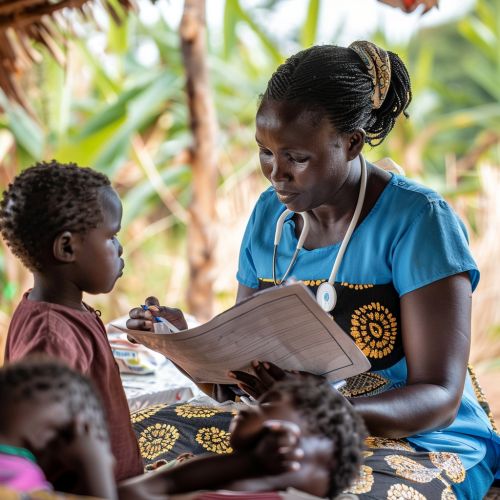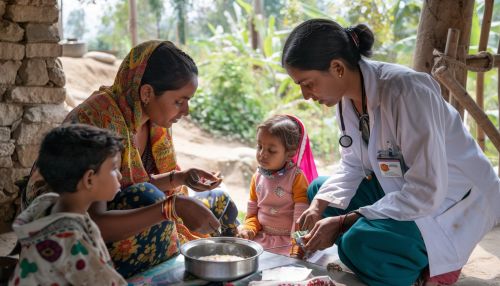Community Health
Introduction
Community health is a field of public health that focuses on the health status and health needs of the population in a specific community. It encompasses a wide range of activities aimed at improving the health and well-being of community members through preventive, promotive, and curative services. Community health initiatives are often tailored to address the unique social, economic, and environmental factors that influence health outcomes within a community.
Historical Context
The concept of community health has evolved significantly over time. In the early 20th century, public health efforts were primarily focused on controlling infectious diseases through sanitation, vaccination, and quarantine measures. The establishment of public health departments and the implementation of health education programs marked the beginning of organized community health efforts.
In the mid-20th century, the focus shifted towards addressing chronic diseases and promoting healthy lifestyles. The World Health Organization's (WHO) Alma-Ata Declaration in 1978 emphasized the importance of primary health care and community participation in achieving "Health for All." This declaration laid the foundation for modern community health practices, highlighting the need for comprehensive and accessible health services at the community level.
Key Components of Community Health
Community health encompasses several key components, each playing a crucial role in promoting and maintaining the health of the community.
Primary Health Care
Primary health care (PHC) is the cornerstone of community health. It involves the provision of essential health services that are accessible, affordable, and culturally appropriate. PHC includes preventive, promotive, curative, and rehabilitative services, and it emphasizes the importance of community participation and intersectoral collaboration.
Health Education
Health education is a critical component of community health. It involves the dissemination of information and the development of skills to help individuals and communities make informed decisions about their health. Health education programs often address topics such as nutrition, physical activity, sexual health, substance abuse, and disease prevention.
Disease Prevention and Control
Disease prevention and control efforts aim to reduce the incidence and prevalence of diseases within the community. These efforts include vaccination programs, screening and early detection initiatives, and the implementation of public health policies and regulations. Effective disease prevention and control require collaboration between healthcare providers, public health agencies, and community members.
Environmental Health
Environmental health focuses on the relationship between the environment and human health. It involves the assessment and management of environmental factors that can affect health, such as air and water quality, waste management, and exposure to hazardous substances. Environmental health initiatives aim to create safe and healthy living conditions for community members.
Maternal and Child Health
Maternal and child health (MCH) services are essential for ensuring the health and well-being of mothers and children. MCH programs provide prenatal care, childbirth services, postnatal care, and child health services, including immunizations and growth monitoring. These programs aim to reduce maternal and infant mortality rates and promote healthy development.
Mental Health
Mental health is an integral part of community health. Mental health services include the prevention, diagnosis, and treatment of mental health disorders, as well as the promotion of mental well-being. Community-based mental health programs often focus on reducing stigma, increasing access to care, and providing support for individuals and families affected by mental health issues.
Community Health Assessment
Community health assessment (CHA) is a systematic process used to identify and analyze the health needs and assets of a community. CHA involves the collection and analysis of data on health status, health behaviors, and social determinants of health. The information gathered through CHA is used to inform the development of community health improvement plans (CHIPs) and to prioritize health interventions.
Data Collection Methods
Several methods are used to collect data for CHA, including:
- Surveys and questionnaires
- Focus groups and interviews
- Health records and registries
- Environmental assessments
- Community forums and public meetings
Key Indicators
Key indicators used in CHA include:
- Mortality and morbidity rates
- Prevalence of chronic and infectious diseases
- Health behaviors (e.g., smoking, physical activity, diet)
- Access to healthcare services
- Social determinants of health (e.g., income, education, housing)
Community Health Interventions
Community health interventions are strategies and programs designed to address the health needs identified through CHA. These interventions can be implemented at various levels, including individual, community, and policy levels.
Individual-Level Interventions
Individual-level interventions focus on changing health behaviors and improving health outcomes for individuals. Examples include:
- Health education and counseling
- Screening and early detection programs
- Immunization campaigns
- Chronic disease management programs
Community-Level Interventions
Community-level interventions aim to create supportive environments and promote healthy behaviors within the community. Examples include:
- Community gardens and farmers' markets
- Safe and accessible recreational facilities
- Smoke-free policies and tobacco cessation programs
- Community-based mental health services
Policy-Level Interventions
Policy-level interventions involve the development and implementation of public health policies and regulations that promote health and prevent disease. Examples include:
- Health insurance coverage and access to care
- Environmental regulations (e.g., air and water quality standards)
- Workplace health and safety regulations
- Public health campaigns and advocacy efforts
Challenges in Community Health
Despite the progress made in community health, several challenges remain. These challenges can hinder the effectiveness of community health initiatives and impact the overall health of the community.
Health Disparities
Health disparities refer to differences in health outcomes and access to healthcare services among different population groups. These disparities are often influenced by social determinants of health, such as income, education, and race/ethnicity. Addressing health disparities requires targeted interventions and policies that promote health equity.
Limited Resources
Limited resources, including funding, workforce, and infrastructure, can pose significant challenges to community health efforts. Ensuring adequate resources and support for community health programs is essential for their success and sustainability.
Community Engagement
Engaging community members in health initiatives can be challenging, particularly in communities with low levels of trust in the healthcare system. Building strong relationships and fostering community participation are critical for the success of community health programs.
Emerging Health Threats
Emerging health threats, such as infectious disease outbreaks and environmental hazards, can pose significant challenges to community health. Preparedness and response efforts are essential for mitigating the impact of these threats on the community.
Future Directions
The future of community health will be shaped by several emerging trends and innovations. These developments have the potential to enhance the effectiveness of community health initiatives and improve health outcomes for community members.
Technology and Health Information Systems
Advances in technology and health information systems are transforming community health. Electronic health records (EHRs), telehealth, and mobile health applications are improving access to care and facilitating the collection and analysis of health data. These technologies can enhance the delivery of health services and support data-driven decision-making.
Community-Based Participatory Research
Community-based participatory research (CBPR) is an approach that involves community members in the research process. CBPR aims to address community-identified health issues and promote community empowerment. This approach can lead to more relevant and effective health interventions and foster stronger community-academic partnerships.
Social Determinants of Health
Addressing social determinants of health is increasingly recognized as essential for improving community health. Efforts to address factors such as income, education, housing, and social support can have a significant impact on health outcomes. Integrating social determinants of health into community health programs and policies is a key priority for the future.
Global Health and Community Health
Global health initiatives are increasingly focusing on community health as a means of achieving health equity and improving health outcomes worldwide. Collaboration between global health organizations, governments, and communities is essential for addressing global health challenges and promoting sustainable development.
Conclusion
Community health is a dynamic and multifaceted field that plays a critical role in promoting the health and well-being of populations. By addressing the unique health needs of communities and implementing targeted interventions, community health initiatives can improve health outcomes and reduce health disparities. Continued investment in community health, along with innovative approaches and strong community engagement, is essential for building healthier and more resilient communities.


